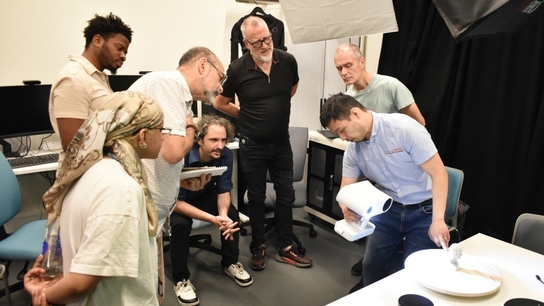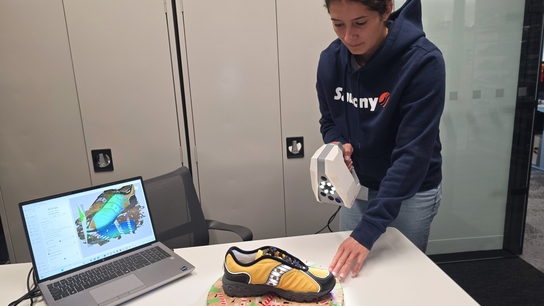Artec 3D scans with no markers for an interactive skull museum
Summary: The St. Cloud University Visualization Lab (VizLab) decided to create an interactive virtual museum of skulls from the specimens at the university’s museum. 3D scanning was needed, but with one rule: no stickers or markers.
The goal: To use Artec 3D’s handheld scanners to scan often fragile museum artifacts, including skulls and other priceless objects on turntables, and then to create highly accurate color 3D models of these.
Tools used: Artec Eva, Spider, Artec Studio
You might not ordinarily think that looking at the skull of a dead animal is a fun thing to do, but the team of the St. Cloud State University Visualization Lab in Minnesota makes you reassess your aesthetic preferences. Watching this video of the proof of concept for their interactive skull museum, you can’t help but admit that their idea of visualizing a collection of skulls from the university museum is eerily endearing.
This mesmerizing effect may well be attributed to the incredibly detailed 3D images of the skulls, and that’s what we should thank Artec Spider and Artec Studio 10 for.
“There really isn’t a practical approach for doing what we use the Spider for otherwise,” says visualization engineer Mark Gill, who heads VizLab.


The skull museum is one of a handful of projects VizLab has been working on. Its mission is to develop visualization, experiential and multimedia solutions to the complex needs of the University community. This includes providing software to support classroom, research and lab activities involving challenges that cannot be easily met with commercially available software.
“We work with the faculty members to provide exactly the lab experience they require,” says Mark. Students who work in the lab to create software get exposure to concepts and technology they normally wouldn’t as part of a regular curriculum.
The lab has recently purchased two Artec 3D scanners, Eva and Spider from Artec's Gold Certified reseller Laser Design, thanks to which the interactive skull museum has become a reality.
“Before we bought our Spider and Eva we simply didn’t do much work like this,” says Mark Gill. “We had modeling tools like 3DS Max, and built most of our models by hand, but accurate capture of real world objects was something we couldn’t do very well. We had been using other consumer-level scanners, which were meeting our needs for very large objects. We also explored some photogrammetry options but had mixed results.”
Spider fills a niche which has been missing at the lab for some time, making it possible, for instance, to reverse engineer old machine parts and create 3D models of archeological artifacts, such as arrowheads or pottery shards. The lab’s team can now 3D-print duplicates of priceless artifacts and compose electronic archives of on-loan museum pieces. “The details of the scans we get from Spider are good enough that we’re starting to explore geometric analysis of the scanned surfaces,” says Mark.
According to him, there is interest in the Art department for the ability to scan 3D sculptures for incorporation into multimedia projects. Having a tool like Spider allows for a rapid integration of physical media into the virtual space. They also plan to start scanning users in order to use a person’s real physical appearance as their avatar in a virtual environment.
The lab has upgraded to Artec Studio 10, and the staff seem more than happy with it.
“It’s the best tool I’ve found for fixing errors in a mesh intended for 3D printing,” says Mark. “I can import a model created in just about any format and quickly prep it for physical prototyping, usually simply by remeshing the model, or applying a sharp fusion to a collection of separate meshes.”
AS 10 has proved a great tool to clean up and present the data from a scanning electron microscope, such as a crystal surface a few microns across, or single-cell organisms. This data often comes in with a bit of noise and a large amount of extra data. With the editing tools of AS 10 the noise can be cleaned up and a mesh fused together.
Now let’s take a closer look at how AS 10 and the Spider were used for the featured project, the interactive skull museum. The museum showcases a collection of mammal skulls from the SCSU museum, the smallest being a mouse and the biggest a cow. They have a wide range of surfaces, textures and sizes. Smaller specimens like the possum and red fox are quite shiny and almost translucent. Next on the plan is digitizing the university’s collection of hominid skulls, which Mark has started working on.





This museum started out as a classroom lab exercise for biology students who study the features passed down by common phylogenetic ancestors. The project is geared for the specific needs of the biology program at the university.
To scan almost all of the pieces, Mark used a scanning turntable, placing random marks on it, to help with registration. Some of the pieces had enough texture so that he didn’t really need the registration aides, but for others it was critical.
Most of the smaller specimens took about an hour to scan and process. The skull and the jaw for each sample were captured in separate scans. The skulls are quite intricate and have complex organic structures, so Mark took about eight scans of each piece to make sure he got features like the teeth from every angle.
“Because these are borrowed from the museum I didn’t want to put any extra marks on the specimens themselves or apply any powder if I could help it,” says Mark. “I set the sensitivity higher on the Spider to handle some of the harder-to-read surfaces.”
The most challenging was the deer skull. Gill did the skull and antlers as different projects, and the jaw as two separate projects. The deer skull alone came to 23 different scans totaling around 12 GB of scan data.
The process of creating the final mesh started with a sharp fusion of the entire skull at a 1 mm resolution. This resulted in meshes ranging in size of just under a million faces for the mouse, and around 4 million faces for the deer. Everything else was somewhere in between.


Mark duplicated the deer skull mesh before simplifying it and applying textures as he needed different versions of the mesh for different parts.
“The mesh simplification in AS 10 is the best I’ve seen,” says Mark. “Other packages allow you to give it some parameters but the final face count is something of a crap shoot and the quality if you decimate the mesh really falls apart. With AS 10 I can type in the exact number of faces I want the mesh to have and I get a mesh with exactly that face count. And it looks so much better than the results I get from other software.”
Mark then rendered the textures to 4096x4096 and exported the very simplified meshes as .obj files with materials.
From there Mark moved the model to 3D Studio Max 2016 to merge the skull/jawbone pairs together. He aligned them the way they should mate up with each other and reset the origin for both models to the same point and alignment. This way they can move together but can also be articulated separately.

After merging the models Mark exported them, still keeping the jaw and skull separate objects as Autodesk .FBX files with media imbedded.
The actual skull museum is built with the Unity 5 Game engine. “I’m targeting some large multi-touch tables we have, so I’m using a framework called Gestureworks to handle to touch manipulation,” says Mark. Unity allows for quickly prototyping most types of 3D interactive applications. It uses C# as a scripting language so that I can program the exact behavior of the skulls; controlling how they move in the game engine, what makes them scale, or their jaws open. Unity also has tools and controls to easily control the lighting and other visual effects.

“Now that the prototype application is done we’ll show it to the faculty from the biology department to see how it matches with their requirements,” says Mark. “Eventually it will allow students to handle these samples and compare them with other specimens without having to worry about actually handling them.”
Scanners behind the story
Try out the world's leading handheld 3D scanners.





